AMD's Richland vs. Intel's Haswell GPU on the Desktop: Radeon HD 8670D vs. Intel HD 4600
by Anand Lal Shimpi on June 6, 2013 12:00 PM EST3DMark and GFXBench
Although we don't draw any conclusions based on 3DMark and GFXBench, I ran this data on Richland as well since I had Trinity, Ivy Bridge and Haswell comparison points.
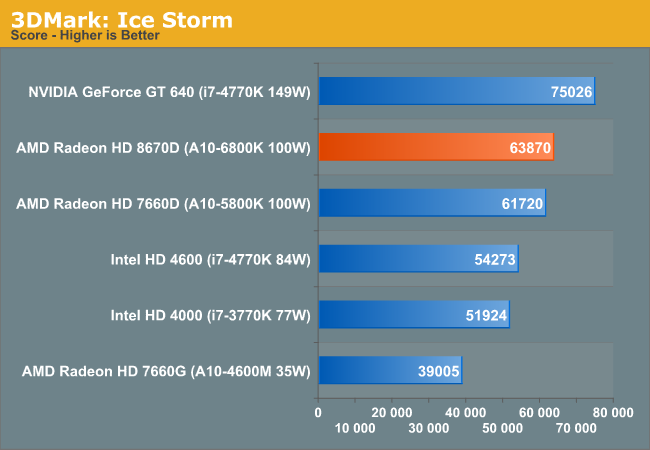
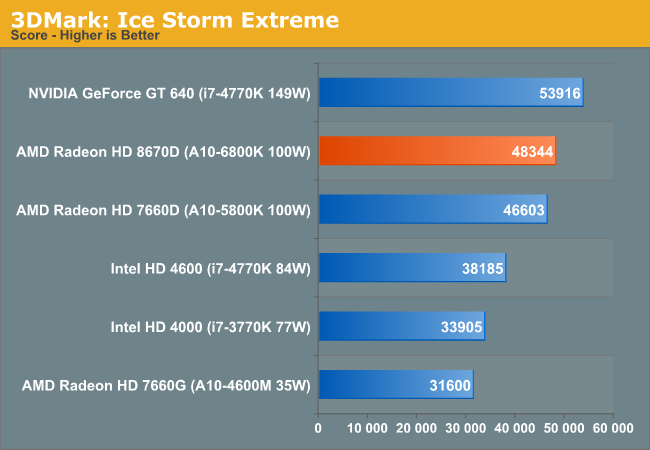
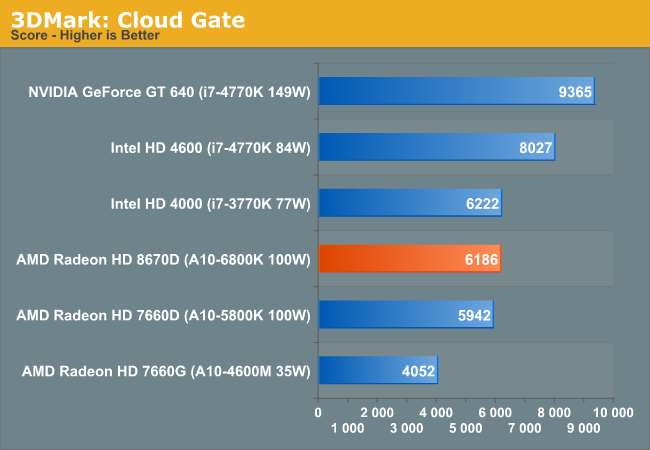
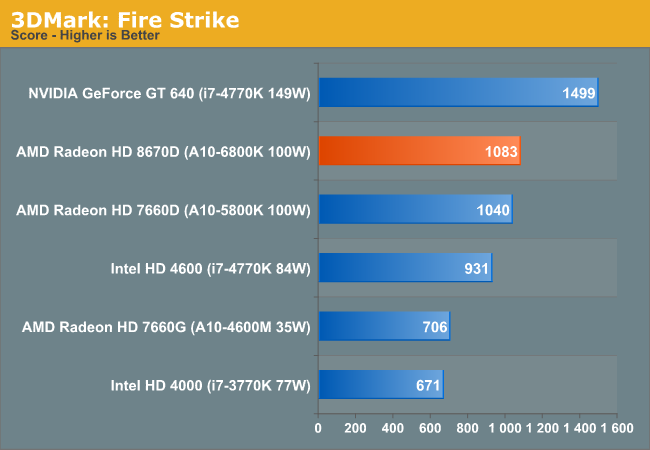
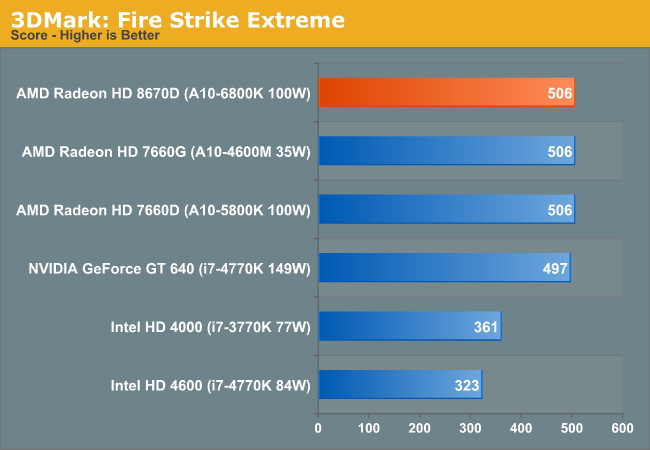

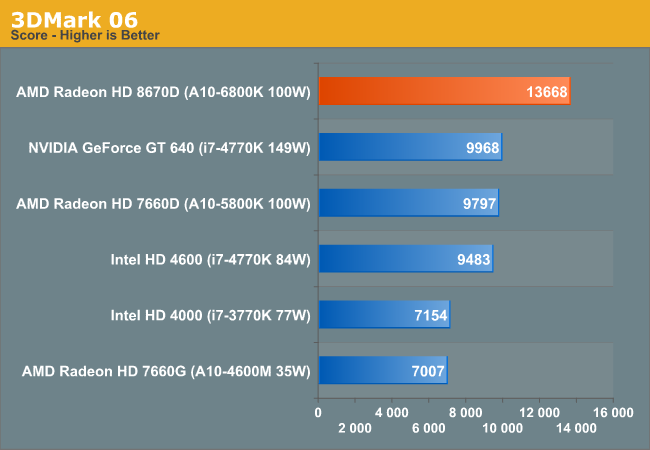
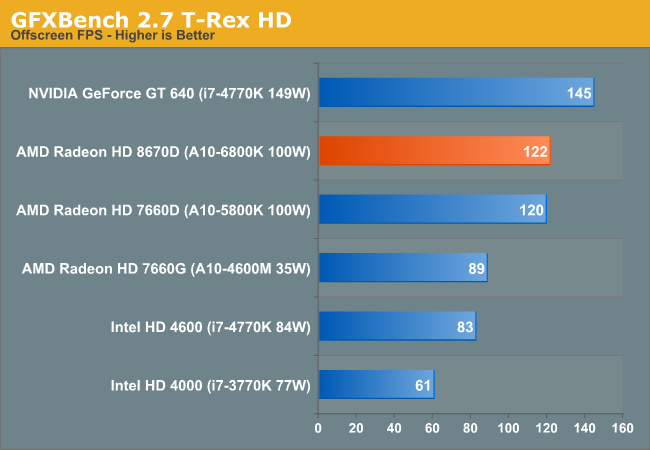











102 Comments
View All Comments
Will Robinson - Sunday, June 9, 2013 - link
LOL...NeelyCam must be crying his eyes out over those results.Good work AMD!
Wurmer - Sunday, June 9, 2013 - link
I still find this article interesting even if IGP are certainly not the main focus of gamers. I don't consider myself a hardcore gamer but I don't game on IGP. I am currently using a 560 GTX which provides me with decent performances in pretty much any situation. On the other hand, it gives an idea of the progress made by IGP. I certainly would enjoy more performance from the one I am using at work which is a GMA 4500 paired with a E8400. There are markets for good IGP but gaming is not of them. As I see it, IGP are more suited to be paired with low to mid CPUs which would make very decent all around machine.lordmetroid - Monday, June 10, 2013 - link
Using high end games that will never be played on the internal graphic processor is totally pointless, why not use something like ETQW?skgiven - Monday, June 10, 2013 - link
Looks like you used a 65W GT640, released just over a year ago.You could have used the slightly newer and faster 49W or 50W models or a 65W GTX640 (37% faster than the 65W GT640).
Better still a GeForce GT 630 Rev. 2 (25W) with the same performance as a 65W GT640!
(I'm sure you don't have every GPU thats ever been released lying around, so just saying whats there).
An i7-4770K, or one of its many siblings, costs ~$350.
For most light gaming and GPU apps, the Celeron G1610T (35W) along with a 49W GT640 would outperform the i7-4770K.
The combined Wattage is exactly the same - 84W but the relative price is $140!
Obviously the 25W GK208 GeForce GT 630 Rev. 2 would save you another $20 and give you a combined TDP of 60W, which is 40% better than the i7-4770K.
It’s likely that there will be a few more GT600 Rev.2 models and the GK700 range has to fill out. Existing mid-range GPU’s offer >5times the performance of the i7-4770K.
The reasons for buying an i7 still have little or nothing to do with its GPU!
skgiven - Monday, June 10, 2013 - link
- meant GTX645 (not GTX640)NoKidding - Monday, June 24, 2013 - link
i shudder to think what an a10 kaveri can bring to the table considering it'll be equipped with amd's gcn architecture and additional ipc improvements. low price + 4 cores + (possibly) hybrid xfire with a 7xxx series radeon? a great starting point for a decent gaming rig. not to mention that the minimum baseline for pc gaming will rise from decent to respectable.Silma - Friday, June 28, 2013 - link
Sometimes I really don't understand your comparisons and even less the conclusions.Why compare a Richland to a Haswell when obviously they will get used for totally different purposes? Who will purchase a desktop Haswell without graphic card for gaming? Why use super expensive 2133 memory with a super bad processor?
There are really 3 conclusions to be had:
- CPU-Wise Richland sucks aplenty
- GPU-Wise there is next to no progress as compared to Trinity, the difference being fully explained by a small frenquency increase.
- If you want cheap desktop gaming you will be much better server by a Pentium G2020 + Radeon HD6670 or HD 7750 for the same price as a crappy A6800 or A6700.
XmenMR - Monday, September 2, 2013 - link
You make me laugh. I normally do not post comments on these things based on the fact that I read them just to get a laugh, but I do have to point out how wrong you are. I have a G1620, G2020, i3-3240, A8, A10 and a more and have ran benchmarks with a 6450, 6570, 6670, 7730, 7750 and 7770 for budget build gaming computers for customers.Your build of a G2020 with a 6670 in my test was beaten, hands down by the A10-6800k hxf with 7750 (yes I said it, hybrid crossfire with 7750, it can be done although not popular supported by AMD). G2020 with 6670 will run you about $130, and an A10 with 7750 is about $230. To match the A10 hxf 7750 ($230 value) performance with Intel I did have to use 7750/7770 or higher with the Pentiums and I3+7750 ($210 value) did quite well but still was beaten in quite a few things graphics related.
Point being a discrete GPU changes the whole aspect of the concept. I3+7750 are very close to A10+hxf7750 in more ways than just performance, but that’s not the point of this Topic. It was AMD 8670D vs Intel HD 4600. I know lots of people that buy Intel i5 and i7 and live off the iGPU thinking one day they would have the money to get a nice GPU and call it good, %60 of the time this does not happen, new tech comes out that’s better and they just change their minds and try to get a whole new system. The APU on the other hand would have been cheaper and performed better for what they needed, had they just gone that road, and I am not the only one that came to that conclusion. AMD has done a great job with the APU and after testing many myself, I have become a believer. Stock i5 computer for $700 got smashed by stock A10 $400 in CS6 sitting side by side, I could not believe it. I do not have to argue how good the APU is doing because Microsoft and Sony have already done it. So I leave with a question. If the APU was not a fantastic alternative that delivers a higher standard of graphics performance, then why are they going to be used in the Xbox1 and PS4?
ezjohny - Tuesday, September 10, 2013 - link
when are we going to get a APU where you could go in game an adjust the graphic setting to very high with out a bottle neck!nanomech - Sunday, December 8, 2013 - link
This is a slanted review. The i7 with the separate Nvidia card skews the results, perhaps erroneously, toward Intel. How about the A10 with the same separate Nvidia card and/or the comparable separate AMD video card? The performance difference can be quite drastic.IMHO, one should compare apples to apples as much as possible. Doing so yields a much more complete comparison. I realize that these APUs tout their built-in graphic abilities, but Intel is trying to do so as well. It's the only way to give the CPU part of the APU a fair shake. That or leave the i7-Nvidia results out completely.